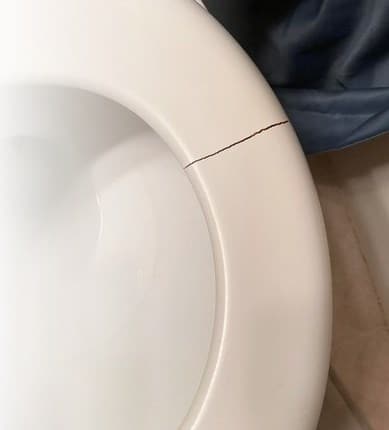While most toilets are designed to hold 500 to 1000 pounds depending on whether they are wall-mounted or floor-mounted, the design of most toilet seats may not be able to withstand that amount of weight.
Toilet seats are designed to hold an average of 300 pounds (136 kgs). Excessive weight or pressure on the toilet seat can cause it to crack, most notably on the hinges or where the seat is fastened to the toilet bowl.
Do you want to know why toilet seats crack? Continue reading to learn about the causes of toilet seat cracking, how to repair a broken toilet seat, and how to prevent further cracking.
In this post, we will cover:
- What makes a toilet seat crack?
- Can you repair a broken toilet seat?
- How to fix a crack toilet seat.
- How to prevent a toilet seat from cracking.
- Best Glue to Seal Broken Toilet Seat
Table of Contents
What makes a toilet seat crack?
In most cases, toilet seats will crack due to excessive weight that exceeds 300 pounds. This is due to excessive movement while sitting on the toilet seat, which causes pressure to build up in certain areas of the toilet seat.
Among the places that are likely to experience cracks are between the hinges, where the seat is connected to the bowl, beneath the seat without bumpers, and the toilet lid without slow-close capability.
Furthermore, the material used for a toilet seat has a significant impact on its durability. For example, if your toilet seat is made of cheap plastic, you are more likely to experience a toilet crack even if you only use the toilet seat occasionally.
Can you repair a broken toilet seat?
Yes. You can easily repair a broken toilet seat if the part that has broken off is fairly small and can be held with two-part epoxy glue.
It is imperative to note that the toilet seat is at risk of breaking again after a repair, especially if it is frequently used.
If the broken piece is quite large, it is better to spend the extra money on a new toilet seat rather than attempting to repair the broken one after it has broken.
How to Fix Cracked Toilet Seat

Repairing a toilet seat is a low-cost option that eliminates the need to purchase a new toilet seat. To repair a broken toilet seat, follow these simple steps. You will also need the following items to complete the task.
- A sponge and a cleaning detergent.
- Cleaning gloves.
- Some old newspapers.
- Wood glue for wooden toilet seats.
- Two-part epoxy glue (such as the Gorilla 2 part epoxy glue) for plastic toilets
Step 1: Detaching
Remove the toilet seat from the toilet bowl by unscrewing the bolts from the hinges holding the toilet seat.
Step 2: Cleaning
Clean the toilet seat using a sponge and mild detergent to remove any dirt that might be stuck on the toilet seat.
Avoid using an abrasive brush to clean the toilet seat or excessive pressure as that could worsen the crack on the seat.
Dry the toilet seat well using a rag or a dry sponge.
Step 3: Repair
Wooden Toilet Seat
If you are repairing a wooden toilet seat, start by prying the crack open to create a small space where you will pour the glue. This approach is suitable for a hairline crack.
If you are dealing with a larger crack, simply pour the wood glue into the crack. Choosing a wood glue with a nozzle will enable you to get the glue into the crack easily.
Ensure that you fill the entire inner part of the crack with glue so that it will bond well to the wood. You can press opposite sides of the area where the crack has occurred for a few minutes to help the glue hold on to the wood well.
Alternatively, you can use a bar clamp to squeeze the wood and ensure that the crack in the toilet seat will be sealed perfectly. After placing the bar clamp, ensure that you wipe off any excess glue that might have accumulated on the outer part of the crack.
Plastic Toilet Seat
If you are repairing a plastic toilet seat, you can repair it using two-part epoxy glue. You would need to ensure that the toilet seat is clean and dry first before applying the glue.
Mix the two-part epoxy glue and spread it well in the crack. Ensure that the glue gets inside the crack for proper bonding.
You can use a bar clamp to secure the area of the toilet seat which was cracked. Leave the epoxy overnight to cure before placing it back on the toilet and using it.
Recommended:-
Best Glue for Broken Toilet Seats
Problem with Toilet Seat Peeling – Here are Causes & Solutions
Best Glue to Seal Broken Toilet Seat
Gorilla Two-part Epoxy Glue

The most appropriate glue to seal a broken toilet seat depends on the type of toilet seat that you are using. If you are using a plastic or wooden toilet seat, the gorilla two-part epoxy glue is a viable option as it bonds wood and thick plastics well.
Buy Now on Amazon
Tips on How to Prevent Toilet Seats from Cracking
Ensure that the bolts are well secured
You should ensure that the bolts are well secured so that the toilet seat does not keep shifting when you sit on it. A toilet seat that is loosely attached to the toilet bowl has a higher likelihood of cracking.
Purchase a toilet seat that is made from Polypropylene.
Toilet seats made from Polypropylene are durable, stain-resistant, and scratch-resistant, plus they feature a strong hinge and underside grip bumper that will prevent the seat from moving when sat on.
Install seat stabilizers
Choosing a toilet seat that includes a seat stabilizer will prevent the seat from wobbling when using the toilet. These bumpers are designed to withstand pressure and to hold the seat firmly on the toilet rim with precise pressure, thus reducing seat wobbling.
Cleaning and Drying
If your toilet seat is made of wood ensure that you dry the seat well after cleaning it. Water breaks down wood and rots it. It also promotes the formation of mold, which can also affect the quality of the wood.
The effects of water on wood promote deterioration, which makes it easy for the wood to crack under pressure. As such, when you clean your toilet seat, ensure that you dry it well.
You should also keep the toilet lid open after cleaning to ensure that the hinges air dry. This will further reduce the risks of water damage and increase the longevity of your toilet seat.
Conclusion
If you notice a small crack in your toilet seat, repair it as soon as possible. Cracks form at a weak point. If you do not repair the crack in a timely manner, it may grow larger and necessitate the replacement of the toilet seat.
In this post, we discussed some of the most effective ways and tricks for preventing your toilet seat from cracking, as well as ways to patch together your broken toilet seat.
We hope that you have been able to complete this task without difficulties. If you are interested, you can read a guide to the most suitable glue for plastic toilet seats.
Read: Hard Water Stain Resistant Toilet Seats
Do toilet seats have a set weight limit?
Toilet seats have weight limits that range from 300 pounds to 400 pounds. If you exceed the weight limit, you are more likely to stress the seat, making it prone to breakages, loose toilet seat hinges, and cracks in the bumper grips.
Why do wooden toilet seats tend to crack?
Wooden toilet seats are prone to cracking when exposed to excessive humidity, weights greater than 400 pounds, or moisture. The majority of wooden toilet seats are made in such a way that the wood is molded incomplete steam to produce an elongated or round shape.
So, if the seat is exposed to moisture or high humidity, it tends to absorb the moisture, softening the wooden structure of the toilet seat, so that when pressure is applied when even one person is sitting on the toilet seat, it easily cracks and can even break into pieces.
Which is better: a wooden or plastic toilet seat?
Although it is obvious that this is a matter of personal opinion, both plastic and wooden toilet seats have fantastic functionalities that improve the user experience when using the toilet.
Although wooden seats are more expensive than plastic seats, this is due to the fact that wooden seats are more durable, classy, and comfy. Plastic seats are less expensive, more common, and easier to clean, but they have their own problems, such as being prone to hard water and urine stains.
Both wooden and plastic toilet seats have a slow closure mechanism, which helps the toilet lid close in such a way that it does not smash on the toilet seat after use; all that is required is a gentle touch and the lid closes slowly on its own.
If you’re on a budget, a plastic toilet seat with current features would be a fantastic choice, as these plastic toilet seats provide more than just a user experience and can endure for more than 5 years without needing to be replaced.
And if you are the type of person who is seeking for style, durability, and functionality, then a wooden toilet seat is the way to go because most wooden toilet seats are meticulously made to match most bathroom interior decor, are pleasant, sturdy, and have fantastic functionalities.
The best way to know if your toilet seat is cracked
Some noticeable areas to keep an eye on are the seat hinges, which tend to loosen and crack, beneath the toilet seat on the bumper grip, which absorbs the majority of the pressure when seated on the toilet seat, and on top of the toilet seat surface, which is easily visible.